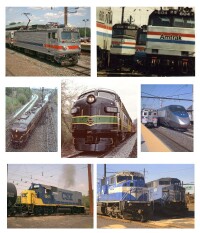| Home | Chapter History | National Info | Chapter Info | CINDERS Newsletter | Our FP7A | Transportation Links | Railfan Links |
 |
The Philadelphia Chapter of the National Railway Historical Society Established in 1936
|
|||||||
Amtrak History
| The National Railroad Passenger Corporation, known as Amtrak, officially began service on May 1, 1971 when Clocker no. 235 departed New York City's Penn Station at 12:05 a.m. bound for Philadelphia on Penn Central's electrified Northeast Corridor. Formed by Congress to relieve the railroads of the financial burden of providing unprofitable passenger service, Amtrak took over the operations of all but three railroads who continued their own intercity passenger train service for a period of time. They were the Rock Island Railroad, the Southern Railway, and the Denver & Rio Grande Western Railroad. The Reading Company also opted out for its runs from Philadelphia to Jersey City and Reading, as they were considered more commuter than intercity, and maintained these trains until the 1980's. | |
| In the early years of operation, Amtrak's equipment was made up of cars and engines from the railroads that signed on. Due to the dire financial straits of eastern railroads, maintenance on these cars and engines was minimal prior to acquisition by Amtrak, and most of the fleet of so called Heritage cars came from the western roads like Union Pacific, Southern Pacific and Burlington Northern. A notable exception was the fleet of stainless steel cars built for the Pennsylvania Railroad by the Budd Company at their Northeast Philadelphia Red Lion Plant. On the NEC, the PRR MP54's (aka the red cars) and Silverliners from Budd and GE held down commuter service, and motive power for locomotive hauled cars was provided by the venerable Pennsylvania GG1's, now under their third owner and in their fourth decade of service, An early Amtrak standout were the relatively new Metroliner multiple unit (or MU) cars, first conceived by the PRR and the Department of Transportation, built by the Budd Company and put into revenue service by the PC. One ofthe first orders of business for Amtrak was to purchase new cars, and they turned to the Budd Company again, ordering the first of hundreds of Amfleet cars, basically unpowered coaches and dining cars based on the Metroliner design. | |
| Amtrak currently operates over more than 22,000 route miles, mostly on the tracks of freight carriers. It owns 730 route miles, about 3% of the total nationwide, primarily the Northeast Corridor between Boston and Washington, DC, and in Michigan. These were acquired on April 1, 1976 as part of the creation of Conrail from the bankrupt Penn Central and other railroads in the Northeast. The Northeast Corridor, of which the New York to Washington DC portion was originally electrified by the Pennsylvania Railroad in the 1930's, is Amtrak's busiest route. On weekdays, Amtrak operates up to 265 trains per day, excluding commuter trains, and over 100 of these trains travel through Philadelphia. As the second busiest station in the system, Philadelphia's 30th Street Station saw over 3.7 million travelers in 2001. 30th Street is also the changeover point for long distance trains. Trains from New York City have their electric locomotives replaced by diesel engines in preparation for travel off the NEC to points in the south and west. Other Amtrak served stations in the area are North Philadelphia, Cornwells Heights and Paoli. | |
| In 2002, Amtrak's roster of equipment includes 2,188 railroad cars including 173 sleeper cars, 743 coach cars, 66 first class/business class cars, 65 dormitory/crew cars, 65 lounge/café/dinette cars, and 83 dining cars. Baggage and Mail and Express cars make up the remainder of the fleet. Amtrak operates 436 locomotives, 360 diesel and 76 electric. Introduced in 2001, twenty Acela Express trainsets will provide high-speed rail service along the Northeast Corridor between Washington and Boston. Two of the three heavy maintenance facilities that Amtrak owns are in the area, the locomotive maintenance shops in Wilmington, DE and the car maintenance shops in Bear, DE, with maintenance also performed at Race Street Yard and Penn Coach Yard adjacent to 30th Street Station in Philadelphia. | |
| Copyright © 2003 John P. Almeida | |
Direct website questions or comments to phillynrhs webmaster
Website created June 12, 2002
Last Updated January 8, 2003